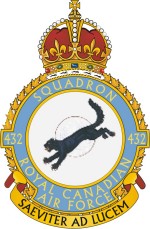| No. 432 (Leaside) Squadron RCAF 432 All Weather Fighter Squadron RCAF | |
|---|---|
 | |
| Active | 1943–1945 1954–1961 |
| Country | |
| Branch | |
| Role | Strategic bombing (1943–1945) Fighter-interceptor (1954–1961) |
| Part of | No. 6 Group RCAF (1943–1945) |
| Nickname(s) | Leaside |
| Motto(s) | Saeviter ad Lucem ("Ferociously towards the light") |
| Battle honours |
|
| Insignia | |
| Squadron Code | QO (1943–1945) |
| Squadron Badge | Argent in front of a full moon Argent a Cougar leaping downwards Sable armed and langued Gules. |
| Aircraft flown | |
| Bomber | Vickers Wellington Mk.X Avro Lancaster Mk.II Handley Page Halifax Mk.III & VII (1943–1945) |
| Fighter | Avro Canada CF-100 Canuck (1954–1961) |
No. 432 Squadron RCAF was a squadron of the Royal Canadian Air Force formed during the Second World War.
History
It was first formed at RAF Skipton-on-Swale in May 1943, as part of No. 6 Group of RAF Bomber Command. The unit was equipped with Wellington Mk.X bombers.
The squadron deployed to RAF East Moor in mid-September, equipping with Lancaster Mk.IIs in October. In February 1944 they changed to Halifax Mk.IIIs, upgrading these to Halifax Mk.VIIs in July.
As part of a Royal Canadian Air Force public relations plan, the town of Leaside officially "adopted" No. 432 Squadron RCAF. Formed and adopted on 1 May 1943 the squadron took the town's name as its nickname, becoming 432 "Leaside" Squadron RCAF. The sponsorship lasted the duration of the war.
The squadron was disbanded at East Moor in May, 1945.
On October 1, 1954, it was reformed as a fighter squadron at CFB Bagotville flying the Canadian designed Avro CF-100. The squadron was again disbanded on October 15, 1961.
Manuel Sharko and Jack Stacy were mid-upper gunners in their respective Halifax bombers during the war.
References
- ^ "RAF Bomber Command No.432 (Leaside) Squadron". raf.mod.uk. 2013. Retrieved 9 September 2013.
- McNeill, Ross (March 1999). "No.432 (Leaside) Squadron RCAF". rafcommands.com. Retrieved 9 September 2013.
- Fletcher, Mark (2013). "An Unimaginable Task : Vintage Wings of Canada". vintagewings.ca. Retrieved 9 September 2013.
- "No. 432 Squadron, Canadian Air Force". canadianwings.com. 2013. Retrieved 9 September 2013.
- Book Reference: The East Moor Experience by Brian Shields
External links
- "432 All Weather Fighter Squadron" (PDF). Department of National Defence Directorate of History and Heritage. (in English and French)
- "432 Squadron Dedication Page". (in English)
- "432 Squadron Facebook Page". Facebook. (in English)
| Canadian Armed Forces | |
|---|---|
| Military history | |
| Leadership | |
| Commands | |
| Academies | |
| Lists | |
| Others | |
| Squadron numbers |
| ||||||||||||||||||||||
|---|---|---|---|---|---|---|---|---|---|---|---|---|---|---|---|---|---|---|---|---|---|---|---|
| Squadron codes |
| ||||||||||||||||||||||
| Aircraft administered and serviced by the RCAF but manned by the Royal Canadian Artillery.
Non-standard code as unit using OW added L. Letters normally denoted parent Command, aircraft type (L Liberator transport, D Dakota etc), unit, and individual aircraft. VC XX | |||||||||||||||||||||||
This Canadian military history article is a stub. You can help Misplaced Pages by expanding it. |